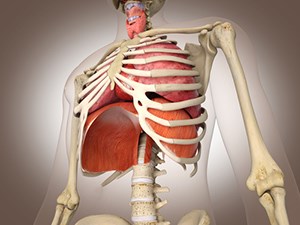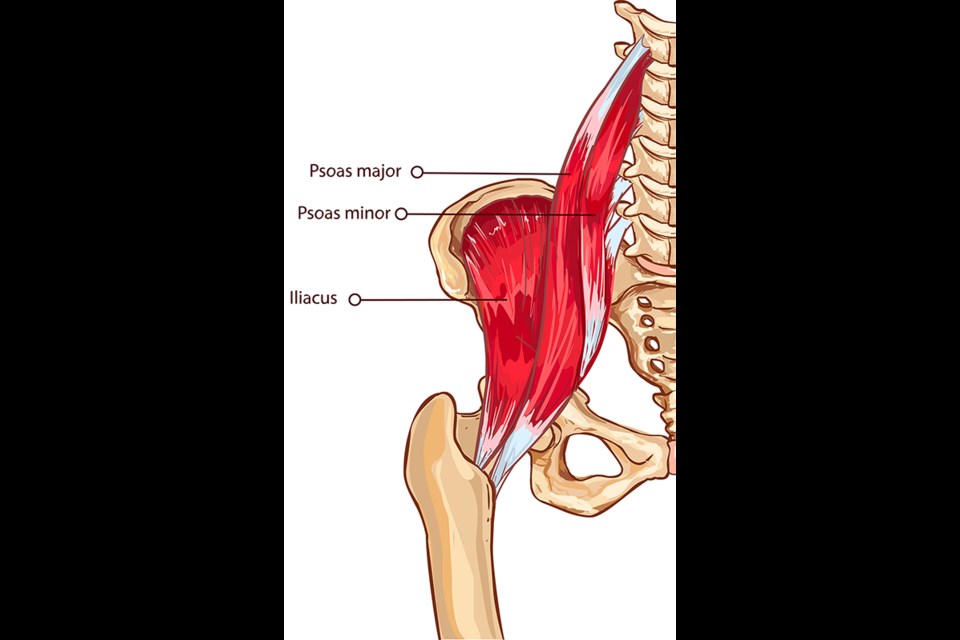What is one of the biggest muscles in your body, crossing three joints, affecting your breathing, and every step you take? Let’s go on a tour of this hidden giant and discover how releasing tension in this muscle can liberate your health and spirit.
Have you guessed yet? It’s the psoas (pronounced so-as) and it is primarily regarded as a hip flexor, although, as with most of our anatomy, it’s a bit more complicated than that.
Let’s first look at the geography. This photo shows an anterior (meaning from the front) view of the left side. The red is meant to represent the muscle fibres. See how the muscle starts up on the spine? It has big, ropey attachments to the front of your vertebrae starting at T12 (just under the bottom of the shoulder blades) to L4/5 (the arch of your low back). It travels along the inside (anterior) side of the hip bones (those are the saucer-shaped ones, either side of the illustration). It emerges at the groin and finishes on the inside of your thigh bone. Stop reading and measure this by touching your body from the mid-back to inner thigh. That’s a long muscle! Because it is so large, the top and bottom of it are often doing different things, which makes it very tricky.
So what does the psoas do for you? It flexes the hip, for starters, which means it bends the leg up into the body or pulls your body down toward your leg. So walking involves lifting a leg, which means the hip flexor is active. It also deeply influences the curve of your low back. In cases of non-specific back pain, I always suspect the psoas. It typically presents as tightness in the thoracic or lumbar area that responds well to gentle stretching and relaxation but gets worse with prolonged standing or sitting. Typically, an exaggerated lumber curve means a tight hip flexor, but flattened back curves can mean psoas malfunction, too. As I said, it’s a tricky character. The muscle also acts as a bit of an external rotator, which means it turns your thigh bone out a bit. If the external rotator muscles are overused (if you tend to walk a bit duck-foot-like, this might be you), this can create hip pain and other conditions such as sciatica.
The psoas crosses the hip joint, sacro-iliac joints and the spinal connections. It is the only muscular connection between the leg and the spine. Misalignment and tension can affect knee, pelvic and shoulder function.
As the psoas travels through the torso, it weaves in amongst all your digestive and reproductive organs. Malfunction or tension in the muscle can contribute to acid reflux, constipation, IBS, fertility problems, menstrual irregularities and cramping, among many other issues.
 Caption
CaptionMoving a bit deeper into our investigation, think of the basic job of the psoas. Hip flexion is called for in fight or flight. We are either going to lift the leg to run or fight, or we might pull the body into the legs to protect our belly. We are deeply hard-wired to initiate a psoas reaction to any environmental irregularity or threat. So did someone criticize your report today at work? That’s an environmental threat to your psoas. Did someone pass you too fast on the highway? Did you feel disappointed that you weren’t invited to lunch? Did you worry about making budget? Was it really loud or too bright? You get the picture.
Many clients ask about stretches for the psoas. It may make much more sense to begin to release the tension of the last few decades a bit first. Aggressive stretches (isn’t this one fun?) can cause damage in the groin and take a long time to heal.
Let’s look at a more patient plan that is safer, quite pleasant to undertake and provides ripples of benefits to all systems of the body.
Legs Up The Chair Pose: This video demonstrates the pose. In this series, plan to spend 5 – 10 minutes here. Get comfortable. Begin breathing in and out the nose, slowly and rhythmically. Gradually take as many full breaths in and out as you can without straining. After the first few minutes, let go of actively breathing and just let nature take its course. Deliberately daydream about pleasant thoughts, like a favourite vacation memory. If an emotional charge comes into your relaxation, gently set it aside, promising to revisit it later.
Half Knee to Chest Pose: Start with both knees bent. Inhale. As you exhale, hug one knee gently to chest, not too tightly. Gradually straighten out other leg to form this shape. Feel the bones of your straight leg as they might be made of iron .... sooooo heavy! Take a few active nostril breaths. Repeat other side.
-
Restorative Psoas Release: Here is a video to demonstrate the whole posture.
-
Restorative Bridge Pose: Again here is a video to guide you through the pose.
Gate Pose: Place a folded blanket under the knee for cushion. Modify to stand on the left leg here if weight-bearing on the knee is painful. Inhale, reach left arm up and exhale to side bend. Move in and out of the posture a few times and then hold for 3 – 5 breaths. As you use your diaphragm fully to breathe, see if you can start to sense the influence that has on the psoas. Repeat other side.
Active Bridge Pose: Place a yoga block, or full roll of toilet paper, between knees. Inhale to lift hips and arms. Exhale to lower. Keep block or toilet paper roll firmly hugged between knees. Repeat 10 breaths.
Savasana (or Relaxation Pose): Lie back on mat, using a pillow under head or rolled blanket under knees for comfort if necessary. Stay as supported by the floor as much as possible for about 2 – 5 minutes.
As you slowly stand up and move about, notice if there is a lightness in your step. The psoas muscles act as guy wires between the leg bone and spine. When they are relaxed and receptive, they conduct the electricity more fluently. These exercises may also be accompanied by a feeling of lightheartedness as they release deeply held stress.



